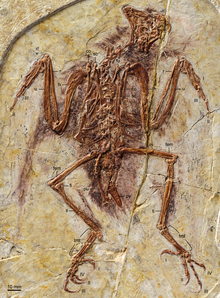| Zhouornis Temporal range: Early Cretaceous | |
|---|---|
 | |
| Holotype specimen | |
| Scientific classification | |
| Domain: | Eukaryota |
| Kingdom: | Animalia |
| Phylum: | Chordata |
| Clade: | Dinosauria |
| Clade: | Saurischia |
| Clade: | Theropoda |
| Clade: | Avialae |
| Clade: | † Enantiornithes |
| Family: | † Bohaiornithidae |
| Genus: | † Zhouornis Zhang et al., 2013 |
| Type species | |
| †Zhouornis hani Zhang et al., 2013 | |

Zhouornis is an extinct genus of enantiornithine dinosaurs known from the Early Cretaceous Jehol Group (Aptian stage) of western Liaoning Province, northeastern China. Zhouornis was first named by Zihui Zhang, Luis M. Chiappe, Gang Han and Anusuya Chinsamy in 2013 and the type species is Zhouornis hani. [1]

